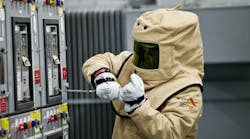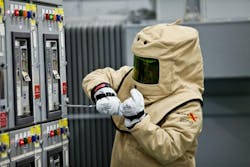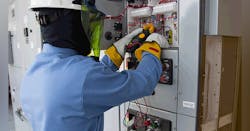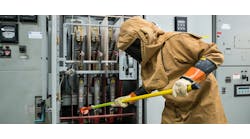Electricians face many challenges on the job, including shock, electrocution, arc flash, and arc blasts, all of which can cause lasting injuries or death. Construction electrical work is considered one of the most dangerous industries on the planet.
Employers have a responsibility to provide their employees with the proper arc flash personal protective equipment (PPE), so workers can protect themselves from electrical-related injuries on the job. There are several factors to consider when choosing the proper safety gear. The wrong brand or material can make all the difference.
Electrical professionals should keep the following in mind when selecting arc flash PPE for electrical work.
Identify potential hazards
The safety gear should be designed to reduce the risk of injury. Every job site presents unique challenges. Employers should start by completing a safety assessment to identify specific hazards in the workplace, including shock, electrocution, and arc flash, as well as other hazards such as rain, snow, extreme temperatures, toxic chemicals, falling objects, and elevated surfaces.
Safety gear should protect workers from all possible hazards without inhibiting their ability to do their jobs. Some workers may have to wear multiple layers of gear to protect themselves from more than one hazard at a time.
Depending on the expertise of your team members, it might be best to get a second opinion. Employers should think about hiring an outside safety consultant to provide additional assistance and make sure all potential risks are properly identified.
Comply with industry standards and regulations
Safety gear also needs to comply with the latest industry standards and regulations. The National Fire Protection Association (NFPA) works in collaboration with the Occupational Safety and Health Administration (OSHA) to draft the latest arc flash safety guidelines for electrical workers. Employers should be familiar with NFPA 70E, Standard for Electrical Safety in the Workplace, an internationally recognized standard that states all employers must use the latest safety-related work practices to prevent injuries related to electrical contact. This includes guidelines for choosing the proper safety gear.
Employers must supply their workers with arc flash rated PPE if there is a risk of fire. NFPA 70E ranks PPE by CAT Levels 1 through 4. Every CAT Level comes with its specific arc flash requirements.
- CAT 1 requires PPE with a minimum arc rating of 4 cal/cm². This typically includes a single layer of arc flash protection.
- CAT 2 requires PPE with a minimum arc rating of 8 cal/cm². Some workers may need more than one layer of arc flash-rated clothing. Many teams often opt for CAT 2 PPE as their basic level of protection.
- CAT 3 requires PPE with a minimum arc rating of 25 cal/cm². This typically includes two to three layers of arc flash-rated clothing, including suit hoods, insulating rubber gloves, and underwear.
- CAT 4 requires PPE with a minimum arc rating of 40 cal/cm². This includes three or more layers of arc flash-rated clothing, including flash suit jackets, face and head protection, and leather footwear.
The NFPA 70E standard is revised every three years to make sure it accurately reflects what’s happening in the field as new products and construction technology are introduced to the market.
The biggest change in the 2021 edition of NFPA 70E is related to arc flash PPE for electrical safety. In earlier editions of the standard, outwear, including coveralls and rain suits, were classified as other forms of PPE. This meant these items had to be at least equal to the protection factor (calorie rating) of the other arc flash clothing being used. This is no longer the case. The standard now states, “The arc rating of outer layers worn over arc-rated clothing as protection from the elements or for other safety purposes, and that are not used as part of a layered system, shall not be required to be equal to or greater than the estimated incident energy exposure.”
This makes it easier for employers to find PPE that complies with the new requirement. As long as the worker is wearing an inner layer of arc flash-rated clothing, the outer layer doesn’t need to comply with the same estimated incident energy exposure requirements.
Fit and comfort
Safety gear won’t be effective if it doesn’t fit the person properly. Electrical workers come in all shapes and sizes, so employers must provide a range of sizes and styles to their employees. The gear should have a strap for securing the item to the person’s body. They should be able to walk around, bend over, and even lay down without worrying about the gear slipping off when they need it most.
Workers should get in the habit of conducting regular fit tests before every shift. They should try moving their bodies in various positions with the gear attached to make sure it doesn’t fall off.
It’s also important to physically inspect each item before wearing it in the field. Workers should look for rips, tears, holes, burn marks, and other signs that the item needs to be replaced. Employers should keep extra arc flash-rated PPE on hand in case of emergency.
Industry reputation
Not all arc flash-rated safety gear is created equal. Some brands and manufacturers have a better reputation than others. Some employers may be tempted to buy safety gear from unvetted suppliers or foreign retailers to save money, but this gear may not be up to the same standards even if it comes with the same arc flash rating. Items might also arrive late or damaged, leading to costly delays in the field.
Employers should spend time researching different companies to make sure the gear they’re buying meets industry standards. If there is a problem with the gear, employers should be able to easily contact the retailer or manufacturer for more information.
Choosing the proper arc flash-rated PPE can be more complicated than some safety managers and employers realize. This information should help industry professionals take the necessary steps to protect their workers from injury in the field.
Rick Pedley is the president and CEO of PK Safety, a supplier of occupational safety and personal protective equipment. The company can be reached at https://www.pksafety.com/contact-us/.





